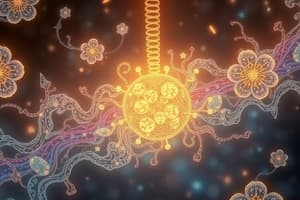Podcast
Questions and Answers
What is the primary energy currency of the cell?
What is the primary energy currency of the cell?
- ADP
- ATP (correct)
- FADH2
- NADH
During which stage of cellular respiration is pyruvate broken down into acetyl-CoA?
During which stage of cellular respiration is pyruvate broken down into acetyl-CoA?
- Electron Transport Chain
- Citric Acid Cycle (correct)
- Glycolysis
- Oxidative Phosphorylation
How many ATP molecules are produced during glycolysis?
How many ATP molecules are produced during glycolysis?
- 4
- 1
- 6
- 2 (correct)
What is the total ATP yield from the complete breakdown of one glucose molecule?
What is the total ATP yield from the complete breakdown of one glucose molecule?
What is the purpose of ATP hydrolysis?
What is the purpose of ATP hydrolysis?
What is the energy source for oxidative phosphorylation?
What is the energy source for oxidative phosphorylation?
What is the primary characteristic of binary fission?
What is the primary characteristic of binary fission?
What is the first step in the process of binary fission?
What is the first step in the process of binary fission?
In which type of cells is binary fission commonly observed?
In which type of cells is binary fission commonly observed?
What is the significance of binary fission in terms of genetic material?
What is the significance of binary fission in terms of genetic material?
How many daughter cells are produced during binary fission?
How many daughter cells are produced during binary fission?
What is an advantage of binary fission?
What is an advantage of binary fission?
Flashcards are hidden until you start studying
Study Notes
ATP and Cellular Respiration
ATP Production
- ATP (Adenosine Triphosphate) is the primary energy currency of the cell
- Produced during cellular respiration through the breakdown of glucose and other organic molecules
- ATP is generated through two main mechanisms:
- Substrate-level phosphorylation: Direct transfer of a phosphate group from a high-energy molecule to ADP
- Oxidative phosphorylation: Energy from electron transport chain is used to generate ATP
Stages of Cellular Respiration
- Glycolysis: Breakdown of glucose into pyruvate, producing 2 ATP and 2 NADH
- Citric Acid Cycle (Krebs Cycle): Breakdown of pyruvate into acetyl-CoA, producing 2 ATP, 6 NADH, and 2 FADH2
- Electron Transport Chain: Transfer of electrons from high-energy molecules to oxygen, generating 32-34 ATP
- Oxidative Phosphorylation: Generation of ATP through the electron transport chain
ATP Yield
- Total ATP yield from complete breakdown of one glucose molecule: 36-38 ATP
- ATP yield from each stage:
- Glycolysis: 2 ATP
- Citric Acid Cycle: 2 ATP
- Electron Transport Chain: 32-34 ATP
ATP Hydrolysis
- ATP is broken down into ADP and Pi (inorganic phosphate) to release energy
- Energy from ATP hydrolysis is used to drive various cellular processes, such as:
- Muscle contraction
- Transport of molecules across cell membranes
- Biosynthesis of macromolecules
Studying That Suits You
Use AI to generate personalized quizzes and flashcards to suit your learning preferences.




